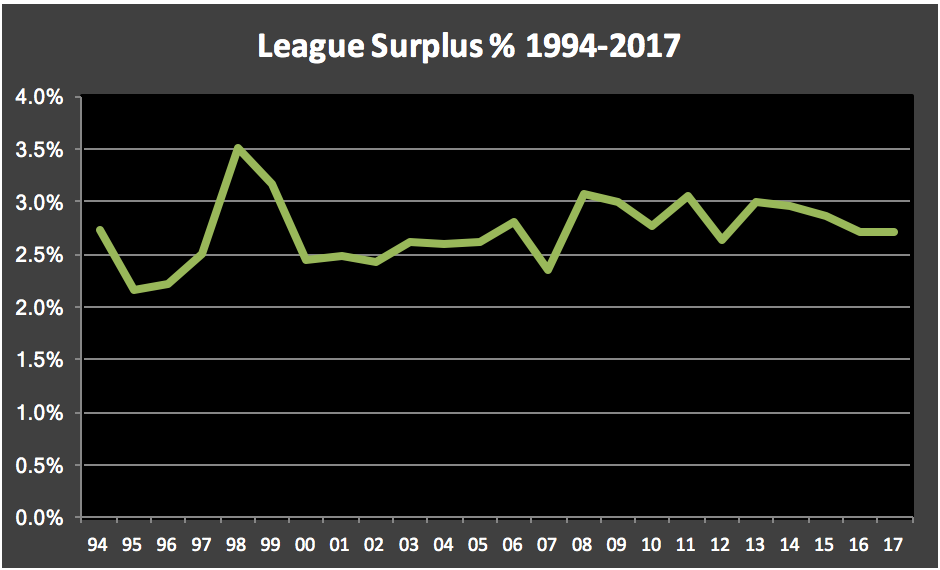Adam Steele is back for another guest post. You can view all of Adam’s posts here. As always, we thank him for contributing.
Earlier this month, I introduced a new stat called Surplus Yards and applied it to the 2017 season. If you haven’t read that post, consider that required background reading.
Since then, I calculated and archived every 40+ yard completion since 1994. The chart below shows the league average Surplus % for each of the last 24 seasons:
The overall average from 1994-2017 is 2.7%, but the trend line begs some interesting questions. Why did Surplus % bottom out in 1995-96 then rocket upward in 1998-99? Why did it spike again in 2008 then plateau for the next decade? Neither of the spikes coincided with rule changes, so I’m guessing the causes were a combination of strategy, personnel, and plain old randomness. If you have any explanations to offer, please share them in the comments!
With that macro level stuff out of the way, let’s take a look at the data for individual QB seasons. Below is a mega-chart displaying every qualifying season (224+ attempts) since 1994. In addition to the three variants of Surplus Yardage, I included the number of big pass plays (40+ yards) plus air yards and YAC per completion. There will be a follow up study detailing the relationship of air yards and YAC with Surplus Yards, but in the meantime maybe you guys can help pick out some trends that I’ve overlooked.
Since an enormous table is rather ungainly to look at, I narrowed it down to seasons with at least 3,000 passing yards, then picked out the top 50 and bottom 50 seasons in Surplus % to view in more detail. First, the top:

As random as Surplus Yards are in the aggregate, the top of the chart doesn’t look like a random list of QB’s. There are a number of great seasons by great QB’s that were pushed into MVP territory by the bonus yardage from long plays. Even compared to the best seasons of big plays, Kurt Warner’s 2000 sticks out like a sore thumb. Warner tallied a ridiculous 306 Surplus Yards in only 11 games, including six completions of at least 72 yards. He had two games in particular that were just bananas: In week 1 against the Broncos, Warner tossed an 80 yard TD to Az-Zahir Hakim and a 72 yard TD to Marshall Faulk (the Hakim play is famous for looking like a relay race). In week 4 vs. Atlanta, Warner threw an 85 yard TD to Torry Holt, an 80 yard TD to Holt, and a 66 yard TD to Isaac Bruce; his stat line for the game was 12/19 for 336 yards!
But let’s be fair, there are some very mediocre QB’s sprinkled among the big play leaders. Nobody thinks J.P. Losman was anything but a bust, yet he managed to rack up the Surplus Yards back in 2006 (fun fact: both of his 83 yard completions occurred in the same quarter against Houston). Josh Freeman did nothing outside out of two decent seasons, RGIII is now a career backup, Jacoby Brissett is an unknown, Tony Banks played forever despite doing little of note, Blake Bortles and Andy Dalton are human memes, and Tyrod Taylor was hated by his own front office. That brings us to Jared Goff, who inspired this whole study in the first place. Will he prove himself to be great over the next few seasons, or was his 2017 breakout a fluke of unsustainable long plays? Regardless of how Goff’s career turns out, the chances of him picking up 230 Surplus Yards again next year are vey low.
Now, the bottom 50:

Here’s where the randomness of Surplus Yardage really comes to the forefront. With a few exceptions, this is chart is populated by plenty of good and great QB’s, some of whom had Pro Bowl seasons in spite of the paucity of bonus yardage. There are a number of QB’s who appear among the top and bottom 50 seasons, reinforcing the idea that Surplus Yards have little to do with the QB himself and are wildly inconsistent from year to year. Matt Hasselbeck shows up on the worst list in 2009 then jumps up to the best list in 2010 and 2011; Bortles made the best list in 2015 and worst list in 2016; Warner has the best Surplus % season and the fourth worst; Alex Smith had two seasons on the worst list before cracking the best list in 2017; RGIII went from best in 2012 to worst in 2013.
I could go on, but you get the point: Randomness rules.

